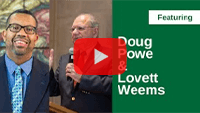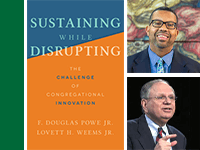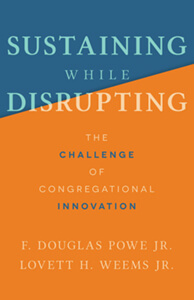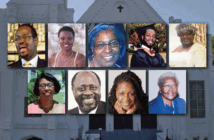
What is required to bring about meaningful change in your church? F. Douglas Powe Jr. and Lovett H. Weems Jr. maintain that genuine change also involves continuity. They outline strategies for sustaining key traditions and systems while simultaneously pursuing new initiatives and innovations.
Listen on Apple Podcasts | YouTube Music | Spotify
Watch on YouTube

- Transcript — Click or Tap to Read
-
Announcer: Leading Ideas Talks is brought to you by the Lewis Center for Church Leadership of Wesley Theological Seminary in Washington, DC. Subscribe free to our weekly e-newsletter, Leading Ideas, at churchleadership.com/leadingideas.
Leading Ideas Talks is also brought you by Sustaining While Disrupting: The Challenge of Congregational Innovation by Douglas Powe and Lovett H. Weems. This book offers theological insights and practical skills to guide church leaders in stewarding traditions while also seeking innovative opportunities for faith communities. Learn more and order now at churchleadership.com/books.
What is required to bring about meaningful change in your church? F. Douglas Powe Jr. and Lovett H. Weems Jr. maintain that genuine change also involves continuity. In this episode they outline strategies for sustaining key traditions and systems while simultaneously pursuing new initiatives and innovations.
Ann Michel: I’m Ann Michel, Senior Consultant with the Lewis Center for Church Leadership of Wesley Theological Seminary. I’m also one of the editors of Leading Ideas e-newsletter. And I am so pleased today to be the host of this episode of Leading Ideas Talks. I’m doubly pleased, in fact, because today I have the opportunity to speak with two of my Lewis Center colleagues, Dr. F. Douglas Powe Jr., who is the current director of the Lewis Center, and Dr. Lovett H. Weems Jr., who is the founding director of the Lewis Center, now serving as Senior Consultant. Doug and Lovett have written a new book together. It’s called Sustaining While Disrupting: The Challenge of Congregational Innovation. And I am delighted today to have the chance to talk with both of you about this important subject. Welcome!
Lovett Weems: Thank you.
Ann Michel: Let’s start with a question addressed to you, Lovett. This book is built around the central premise that genuine change involves continuity — that in order to bring about meaningful change a church leader can’t just focus solely on new innovations and initiatives, but also has to attend to sustaining key traditions and systems. So, I wanted to give you a chance to explain why that’s the case, and why it’s important.
Lovett Weems: The premise of our book is that church leaders have to do two things at once. One is to sustain, and one is to disrupt — that is to sustain the ongoing ministries of the church while at the same time innovating into areas required for the future. Now it’s hard for leaders in the religious world or outside to get this combination right. That is, how much do you focus on sustaining and keeping things going and even improving things and how much do you spend on the new, what’s needed for the future and things that you have not done before or things that you don’t do well now.
Often there’s a tendency for church leaders to see the past as this part of the church that’s not what it used to be and that’s not a source of great vitality right now and to see the future as something different from that past. And with that kind of alignment, leaders will often personally identify more with the future or with innovation. And they see these two as almost competing themes. On the one hand, they have so many demands on them just to keep people happy with what’s going on. But at the same time, they know that they need to be focusing on the future. These have to be seen together — past and future, continuity and change.
For one thing, virtually all of your assets are in the past that is connected to what’s going on now — your people, money, property, credibility. So, you don’t have the ability just to say I can ignore what is in order to work on what may be. It’s not that you’re trying to innovate in spite of all the demands of the present, but instead you’re trying to innovate in light of those assets that you already have.
So, for example, let’s say your congregation is one that has lost its connection to its community.
The members no longer live there. People in the church don’t know people in the community. People in the community don’t know people in the church. There’s very little connection day in, day out, and you’re hoping that can change. So, one way to approach it would be to try to minimize your efforts toward keeping everything going and focus on new efforts to engage the community. But, as you start looking a little closer at the past of this church, you discover it is not always been this way. This church and this community really grew up together. The public school and your church were the first buildings built in the community. When the roof blew off half of the school, the school actually met in the church until the repairs were made. Many, many organizations in the community owe their origin to the church. Many of them used to meet in the church. It was a place for public forums and public gatherings. People used to vote there. Now you look to the future not so much saying, “We’ve got to quit being this ingrown church, and we’ve got to become this new community-based church.” Instead, you’re saying “We’re falling in love with our community again and becoming what we were from the beginning.”
So, leading change is more evolution than revolution. You want to build from that past so that you’re not saying to people, “The future is going to be a church that’s not like anything we’ve been before.” Instead, you’re wanting to say “We’re going to be more of what we’ve always been. We’re going to do more of what God led our forefathers and foremothers to do when this church was started, to commit to this community. Now we’re recommitting to that community.” Continuity and change must go together, but they take different skills and different efforts.
Ann Michel: Thank you for that, Lovett. It really does strike me that you’ve hit on a core truth, this idea that we need to incorporate our tradition and our past when thinking about change. Yet so many other books on congregational change focus so much on the new thing that you could easily assume that it’s unnecessary or unimportant to also focus on what is. I think you’re bringing a very important and balanced perspective to this.
Doug, I wonder if you could address this from a biblical perspective. Are there examples of this approach to change in Scripture?
Doug Powe: We certainly think so, Ann. Lovett and I did want to be careful because, as you are well aware, you can easily make what you are working on or thinking about fit into a certain paradigm. But, trying to avoid that, we do believe that in Acts, though, you find some examples of how you have to hold these two together — sustaining and innovating. And a lot of Acts revolves around this very practical issue of circumcision when it comes to the Jews and the Gentiles. But we think the underlying issue is really how do we pursue God’s calling, whether we’re Jewish or Gentile, right? So how do we really pursue what God is calling us to do as a community, whether or not we’re Jewish or Gentile?
In Acts, you start off with the disciples gathering, and then Peter speaks up and talks about what is revealed to him. And you actually have this community in Acts 2, and this is sustaining and embodying what Jesus had built with the disciples, that they were going to take care of those in their midst who were struggling, that they were going to continue to live out the Scripture, which was for them, of course, the Old Testament. So, you have this sustaining community that is embodying what Jesus delivered to the disciples and sustaining that work in this community.
Then, as you continue reading Acts, it is Peter and Cornelius who both have a dream or vision. And this is where the innovation comes in that Peter envisions Jews and Gentiles together. And today we read this, and we understand that it’s important, but it’s not probably as big of a deal as it would have been to both Peter and Cornelius at that time. This would have been really earth-shattering to them to think about these two groups coming together and Cornelius’s vision of inviting Peter to come to his house.
What is interesting about this is that, although it was Peter that actually has the vision, the innovation really doesn’t get legs until Paul, who of course was Saul before this, picks it up and runs with it. What you have is this outsider, this person who at one point was persecuting Christians, who now sees things differently and sees the Gentiles as a partner in God’s vision for moving forward. So, it’s the outsider that helps the innovation take place. And what you think about this is that it’s hard for us as insiders often to embody something completely new. In Acts, we have Peter, who is brilliant at sustaining what the disciples have learned and doing this very well, as we read in Acts 2. But it takes Paul, an outsider, to really think about how this can move in a different direction. Paul is the one that helps us to connect to the Gentiles and to take what is happening in a different direction, and he does so with the huge risk. He’s saying, “Hey, the Gentiles don’t have to be circumcised.” They can be truly embodying what God is calling and be faithful without being circumcised.
So, in Acts you have this tension that Lovett described of how you can sustain and embody community, which is critically important. But also at the same time, there are ways in which innovations are critical and can take place, but it often involves someone with a different perspective coming from the outside, and it also often involves taking risk. That can be very challenging, particularly for congregations that often like to play it safe.
Ann Michel: Thank you for sharing that example. I’ve always felt that the book of Acts is a great case study in Spirit-led adaptive change, so I think it’s wonderful that you’ve brought that to the surface. It strikes me that this idea of sustaining and disrupting at the same time is vitally important, but I think it’s also doubly challenging for a leader to need to do those two things at the same time. And so, I want to shift a little bit to some of the how questions. What are some of the practices and perspectives a leader can use to balance these two seemingly contrary leadership tasks? Doug, if I could turn to you first, in part of the book, you talk about some of the essentials on the sustaining side of the equation. I wonder if you could just speak to some of those.
Doug Powe: Yeah. Let me just highlight a couple, Ann. As pastors, I think it is really critically important that we help others to live into the vision of the church, that we help those who have been a part of the church for 50 years and those who just joined the church last week to live into the mission and vision of the church. And a key component or a key piece of doing this is that we’re helping individuals grow in their relationship with God. This means that we have to have vital worship so that they can grow in the way that they love God. We have to have vital ministries where they are able to connect with their neighbors and to live out loving their neighbor and to express that piece of what it means to participate in God’s vision. Leaders and congregations play a critical role in making sure that worship is vital, ministries are vital, and that they are giving opportunities for those in the congregation, regardless of where they are in their journey, to really grow in their relationship with God. When you ignore this just to try new things, then you’re not sustaining what Lovett talked about earlier, those key foundational pieces that have helped the church to get where it is today.
Another piece of this, of course, is pastoral care. Pastoral care is also critical for a church leader. Taking care of the flock, taking a journey with folk as they’re dealing with life’s challenges is really important. You can’t overlook this in terms of sustaining the congregation. So, helping a congregation to really know that you are walking with them as they face these different challenges in life is how a leader can sustain a congregation. If a leader simply ignores these things, while they might be brilliant at creating new things, it’s going to still be a challenge for them because the church is not going to be truly living out a vision or mission that it’s been called to do.
 Sustaining While Disrupting: The Challenge of Congregational Innovation
Sustaining While Disrupting: The Challenge of Congregational Innovation
In this new book, F. Douglas Powe Jr. and Lovett H. Weems Jr. offer theological insights and practical skills to guide church leaders in stewarding traditions while also seeking innovative opportunities for faith communities. Learn more and order now at churchleadership.com/books.
Ann Michel: Another skill set that you emphasize in the book, Lovett, is the “So That” formula. This again is something that people who are familiar with the Lewis Center’s work may have heard of in the past. But you talk about how these two little words, “So That,” can be so important to leadership and change. Can you talk about that a bit?
Lovett Weems: Yes. The church tends to focus a great deal on intentions and activities. But the Bible talks more about fruitfulness. What is the harvest God is calling us to reap? The phrase “So That” is one that Tom Berlin and I developed in our book Bearing Fruit, in which we call it the two most important words for fruitful leadership. The classic example of why it’s so needed is Vacation Bible School. It’s one of the most common activities that churches of many different sizes, traditions, locations have every year, and yet it’s virtually impossible to define. Even in the most active and vital congregations, anyone that can complete the sentence, “Each year we have vacation Bible school so that ….,” or at least to complete it in a way so the “So That” refers not to activities but to what we hope God will do in the lives of the children, their parents, and in our community because of it. But, you see, unless you’re clear on what that end goal is, you don’t know what teachers to recruit, you don’t know what literature to use, you may not even know whether it should be in the daytime or at night or whether it should be free or if you can charge a fee. The “So That” determines everything else but that’s the way we handle so many things: the question is not “Is our Vacation Bible School achieving what God called us to do with that?” but rather “Did we have it?”
We treat other things the same way. Take the worship. We think of worship in terms of the activities, and we do those well. But have we ever said “Our church has worship so that …? What do we expect will be different because we do worship? One year from now, if we do worship well, how will the lives of our members be different? How will our community be different one year from now?” Once you’ve identified that, you can say “We have a choir so that ….” It’s not about music apart from the “So That” or the purpose of our worship.
Ann Michel: Yeah, it has always seemed to me that this idea of “So That” is another way of saying we need to be clear about why we’re doing something. I sometimes talk about the importance of why, and that’s always pointing back to “do our activities and actions relate to the Church’s ultimate mission?” Because I think, in so many areas in some of the examples that you’ve given, the church has forgotten why it does what it does and instead just thinks that it needs to be about doing what has always done. I think this “So That” idea is such a simple but powerful way of keeping churches focused on the importance of why, so thank you for that.
At another point in the book, you suggest four criteria for discerning what a congregation’s next faithful steps might be. And there’s so much in that, because this idea of what are your next faithful steps is significant in and of itself. Doug, I wondered if you could speak to that.
Doug Powe: I’d be happy to. Let me begin by saying we haven’t talked as much about this piece of it. But the book, as you know, Ann, along with helping people think about sustaining, which we think is what we’re really adding to the conversation, we also really talk about what does it mean to innovate and to take the next faithful step. We’re really trying to help leaders think about the balance between those two. How do you take the next faithful step in terms of sustaining? But, also, what are some things you can think about the next faithful step in terms of innovation?
So having said that, the first thing that we talk about is potential. How do we determine the potential for something we want to either sustain? Or how do we determine the potential for something that we may want to innovate? And that means we have to evaluate some of the priorities of the congregation. We have to evaluate our mission and what it is that we’re trying to do. Sometime in a congregation we’ll make statements like “We want to reach young families.” That’s the priority of the congregation, and you know we’ll be disappointed that young families are not a major part of our congregation. So, what needs to happen often is we’ve got to really figure out what is happening in our congregation. And one way to get at this issue is to figure out “what are the rhythms of the congregation? What are the things that are occurring in our congregation?” as we’re thinking about potential.
Again, sometimes an outsider can help us see this, so inviting someone who’s not connected to the congregation to come to worship, to come to a business meeting, to come to some of the Sunday school classes or ministries, just to observe and see what’s going on. Let’s say one of these people shows up at worship, and what they notice is that, when a child in the congregation makes a noise or moves, people start staring or people start whispering quietly and it makes the family feel uncomfortable. So, while the congregation says, “We want to reach young families,” the potential to do so is diminished by the very rhythms of how they actually live out their life and worship together. Really trying to figure out our rhythms helps us to figure out the potential for what it is that we’re trying to do.
Then we think about reach. Reach helps us to think not only about who it is we’re saying we want to reach, but what actually will help us to make that happen. Again, if we’re trying to reach young families, then we really need to study our community. We need to know if there are schools close by in the community where people or young children are going. Are there other places where children are playing outside, or activities where we actually see children in our community?” Just to make a statement — we want to reach children — when we haven’t actually studied our community or studied what has taken place, sets us up for failure. It makes sense to actually figure out, “What do we need to do to actually reach those that we are seeking to connect with.” As Lovett says, that actually starts with the question, “What do we need to learn?” What we need to learn is are they in our community and what are they doing in our community, so that we have the actual potential to make this happen.
The third one, for me, I think is what is critically important, and that’s readiness. So many times we have a potential to do something. We actually have studied the community so we know that the children are there because there’s an elementary school a block away from us. But are we actually ready for them to be a part of our congregation? This readiness question is key because, again, if many people in our congregation say, “Well, we really would prefer the children go to children’s church. We don’t want them in the worship service,” we may not be ready to welcome families into our community. We may have to do some internal work to talk about it. If we’re saying families are a priority, then we’re going to have to think about what that really means in terms of how we are going to connect with them. And if we are committed to saying we want children in children’s church, then we may not be the family community that we think we are so. So, readiness is something that I think congregations skip over too often in terms of taking the next faithful step.
And finally, Ann, is fit. Once you’re ready, is it really a good fit for them to be in our congregation. Are we willing to make space for them to be a part of who we are? Here, just switching the analogy, in this new world of where we’re using hybrid, are we simply letting people look at the worship service that we are doing, and we don’t change anything. Or are we willing to actually change something so that they can have an experience where they feel like they’re part of it? Are we willing to let them fit into what it is that we’re trying to do?
Potential, reach, readiness, and fit help us to take the next faithful step, whether we’re trying to sustain or whether we’re trying innovate.
Ann Michel: I wondered whether you have suggestions for how to order and discipline a congregation’s decision making, so that all of these different considerations that you have brought to the table can be implemented within a congregations actual, day-to-day decision making .
Doug Powe: Leaders really need to start with a self-evaluation. Oftentimes, we sort of naturally are better at sustaining or naturally are better at that really creative edge of trying to push the envelope. And both of these are needed as we suggest. But knowing your own strengths and even what you prefer can help you to build capacity in the other area or in what you need to do to help the congregation to move forward, because I think that sometimes we think that one person can do everything. As we all know, that’s not possible. The key is really understanding your strengths and then having others around you who might be able to help you to build capacity in those places where you’re not as strong. So, have the leader do that first, and they can do that, of course, through discernment on their own. But I also think other people around them certainly can be helpful in this case. Other people will recognize naturally some of the gifts a leader will have in one of those places. Recognizing that and knowing that so that you know where you need to build capacity I think is the place to start.
Then, the next thing that I would say is think about starting smaller. I think oftentimes we want to move from “A” to at least “M” skipping over all the other letters of the alphabet. And sometimes what you just need to do is go from “A” to “B” right? You just need to take “that next faithful step.” You don’t have to get the end. If you make it to “B” you actually have done something that is wonderful. That would be the second thing that I think is key — just helping leaders help the congregation think “You just need to get to ‘B.’” I think oftentimes, and I know I’m guilty of it, we try to help congregations dream so big that we make it sound like “You have to become this next great thing.” And the reality is, “No. You have to be authentic to who you are taking your journey.” And that may mean you have to get to “B.” And that has to be the goal. I think those two things would be what I would add to what Lovett said.
Ann Michel: Maybe you’ve already answered this, but I like to end these podcasts by asking about first steps or how someone might best get started. And so, if a church leader wanted to really take the advice in your book to heart and move forward with an approach to change that balances sustaining and disrupting, what would be a good first step? Doug, why don’t we stay with you and then I’ll let Lovett have the last word.
Doug Powe: Absolutely. Well, the first thing, of course, is they should buy the book. That’s the number one thing. So, that’s the obvious. And then I think what would be really important for a leader is to really think about it, and Lovett talked about this well today, to really think about what it is that they need to learn in terms of where it is that they’re trying to help the congregation to move. I think oftentimes, again, that we go to workshops or we hear people talk and we get great ideas, and then we just sort of get “gung ho.” But what we really need to think about is, what do we need to learn if our goal is to start a second service? What do we need to learn if our goal is to reach young families in the community? Really starting with what we need to learn about whatever the ideas is. I think at first it can feel like you’re not doing anything when you’re taking that first step, but that learning is really critical if you’re really going to succeed and move forward.
Ann Michel: Thank you. And Lovett, how about you? What’s the best first step for somebody who’s just starting down this road of leadership?
Lovett Weems: Well, I like to say leaders don’t have to have the answers, but they must have the right questions. And a question a leader might start with for himself or herself, and also to ask many, many other people who are knowledgeable about the situation, is to think five years into the future. Thinking about your church and it’s vitality, where is your church most vulnerable five years from now? What is the greatest vulnerability for you? And, on the other hand, what is something that, if done well, could make your church far more vital five years from now? In other words, what’s the big issue? The notion of taking the next faithful step works because it’s toward something else. Refurbishing the fellowship hall to make it accessible to the community is not an end in itself. But it’s toward that same future of reengaging the community, just as the music ministry beginning a community choir for children is moving toward that point. None of the smaller things by themselves will reach that preferred future but many of those things working together. And that’s why you’re able to get to a point where, in looking back, you say we never could have dreamed that we would be here. Too many of us are focused too much on the present without getting the big picture and helping others to get that big picture, so we’re not clear on that vision to which God is most calling us now.
Ann Michel: Well, thank you for that. Again, the book is Sustaining While Disrupting: The Challenge of Congregational Innovation. And I want to thank both of you for this conversation, but also for the book. When I heard that you were writing a book on congregational change, I did not envy you the task, because I know how many other people have written on this subject. But I was so delighted to find in your book that you have offered something that is very novel and very practical. And I think it’s going to be a great help to so many people. So ,thank you for the book. Thank you for all that you do for the Lewis Center and for this wonderful conversation today.
Announcer: Thank you for joining us for Leading Ideas Talks.
Don’t forget to subscribe to our free weekly e-newsletter, Leading Ideas, to be notified when new episodes are published. Visit churchleadership.com/leadingideas.
 Related Resources
Related Resources
-
- Sustaining While Disrupting: The Challenge of Congregational Innovation (Fortress Press: 2022) by F. Douglas Powe Jr. and Lovett H. Weems Jr. Available at Fortress Press, Cokesbury, and Amazon.
- The Messy Art of Leading Change: An In-Depth Interview with Mike Bonem
- Conquering the Challenges of Change by Ann A. Michel
- Does Your Faith Community Live out of Memory or Imagination? by Bill Wilson




